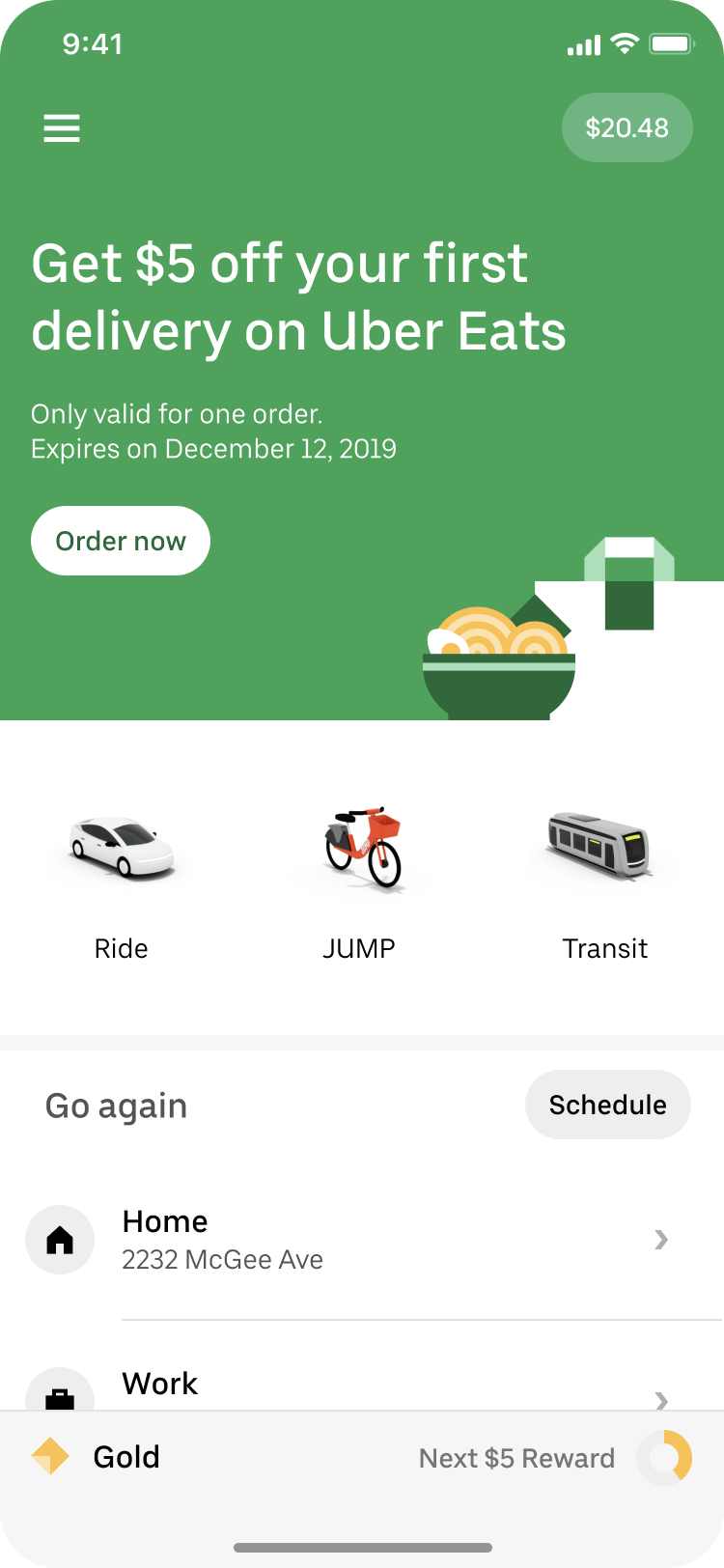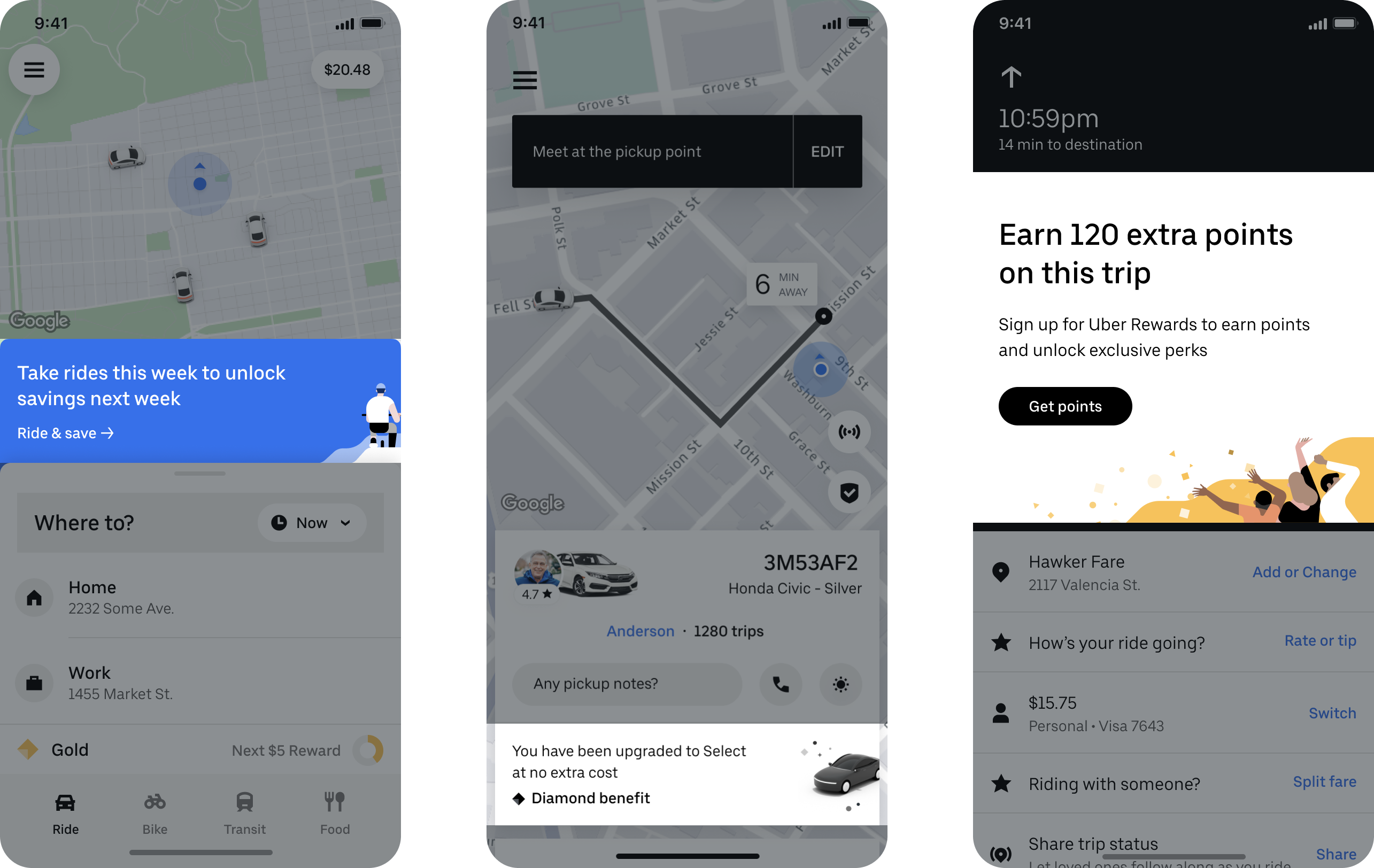Personalizing Uber.
As Uber has grown beyond rideshare into a service that helps you go places and get things, we needed to rethink the core rides experience to better address the needs of everyday life. What started as a blue-sky exploration landed in a complete re-imagining of the purpose messaging within the app. This not only required a redesign, but a dramatic shift in the way we develop content and communicate with users.
My role was to define the scope of the ask, identify and lead a cross-disciplinary team, and ensure we defined clear milestones for leadership buy-in. As we transitioned from concept to execution, my role shifted to less hands-on direction, allowing designers the space to define and drive the right solutions, but ensuring the work was always connected back to the vision.
Vision
Messaging that helps you navigate everyday life.
A unified and coordinated "always on" discovery experience to encourage adoption of new and existing services across the product.
Goals
Efficient.
Uber gives you your time back.
Contextual.
Uber understands you to serve you better.
Consistent.
Uber has your trust and confidence.
Drives adoption.
Increase revenue and engagement.
Drives internal efficiency.
Rapidly experiment and grow new services.
Drives brand positioning.
Become synonymous with everyday needs.
User insights.
Users come to Uber with clear intent, ignoring what they perceive as irrevelevant content.
Users are receptive to learn about and use new services, so long as they're in a context that matches their mental state.
A limited surface with little relevance.
The existing surface had a number of pain points. Its dominating size detracted high-intent users, even pushing "Home" and "Work" shortcuts off the screen on smaller phones. The visual design only supported a limited color palette and small illustrations. Most importantly, internal teams were ill-trained in content development, leading to impersonal promotions detached from our powerful targeting capabilities.


An inconsistent journey leads to missed opportunities.
Every messaging surface across the product was designed with different specs and poor guidance on how to capture user intention at discrete points of the journey. Despite data showing higher click-through rates en route and on trip, internal teams used home screen surfaces a disproportionate amount of the time. Additionally, very few (if any) campaigns customized their messages based on user context (waiting for a ride or already in one?).
Exploring the possibilities.
I lead a team of designers, illustrators, and copywriters through a three-week, blue-sky conceptual exploration, landing on four distinct territories. Through a collaborative process with our product partners, we pulled out the best and most feasible ideas to bring to cross-functional leadership for alignment and buy-in.
Conversational?

Anchored in routine?

Driven by search?

Your calendar?


Bringing the vision to life through narrative storytelling.
We refined our conceptual thinking into a succinct narrative that spanned three types of users, all connected by the family unit. By bringing these features to life in the context of our users, we were able to double down on the importance and impact of the changes we were proposing.

Actions, not ads.
Our vision highlighted how through the use of context and personalization, traditional advertising surfaces could be transformed into meaningful, assistive actions.
From concept to execution: standardizing our components.
We worked with the design platform team to create a system of uniform components that would cut down on internal asset creation time, allow for faster experimentation, and create consistency across the user journey.

Building consistency across the entire journey.
The previous design system only allowed for small illustrations, causing consistency issues with marketing efforts and limiting the representation of the full brand identity. The new system accomodates all types of assets, allowing for the full expression of Uber's brand across the entire customer experience.
Guiding by doing: over 100 new messages created.
With the components moving into production, I resourced a creative team and, in partnership with PMM, produced over 100 evergreen messages and content guidelines in time for the redesign rollout. In addition, we held office hours and trainings with global stakeholders to help teams understand the vision and how to bring it to life.

From generic to contextual.
By using simple data like time of day, we turned generic Eats promos into more contextually relevant messages.

The right message at the right time.
By taking into consideration day of the week, we're able to turn seemingly irrelevant product upsells into helpful recommendations and services.

Turning value props into meaningful messages.
We audited nine of the highest priority products and services and developed unique concepts based on their core value props. We combined these concepts with variable data to create contextually relevant messages that feel assistive, not interruptive.

Marketing as an integrated part of the product.
In our vision, we laid out a clear idea: we need to radically rethink our in-app marketing—not just as a surface, but as an integrated part of the experience. In conversations with product leadership, this approach alleviated concerns around losing high-intent users. By aligning marketing and product, we were able to re-imagine how a traditional ad space could be used to solve real-world problems.
brand
Design Direction
Dan Schwer
Product Design
Joan Pons & Josh White
Program Management
Ioannis Argiris
Illustration
Jordon Cheung, Aldo Hernandez, & Giulia Giovannini
Production Design
Elena Costello & Seth Jones
product